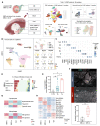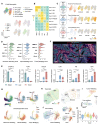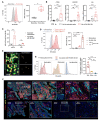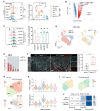Multi-model analysis of gallbladder cancer reveals the role of OxLDL-absorbing neutrophils in promoting liver invasion
- PMID: 38822440
- PMCID: PMC11140996
- DOI: 10.1186/s40164-024-00521-7
Multi-model analysis of gallbladder cancer reveals the role of OxLDL-absorbing neutrophils in promoting liver invasion
Abstract
Background: Gallbladder cancer (GBC) is the most common and lethal malignancy of the biliary tract that lacks effective therapy. In many GBC cases, infiltration into adjacent organs or distant metastasis happened long before the diagnosis, especially the direct liver invasion, which is the most common and unfavorable way of spreading.
Methods: Single-cell RNA sequencing (scRNA-seq), spatial transcriptomics (ST), proteomics, and multiplexed immunohistochemistry (mIHC) were performed on GBC across multiple tumor stages to characterize the tumor microenvironment (TME), focusing specifically on the preferential enrichment of neutrophils in GBC liver invasion (GBC-LI).
Results: Multi-model Analysis reveals the immunosuppressive TME of GBC-LI that was characterized by the enrichment of neutrophils at the invasive front. We identified the context-dependent transcriptional states of neutrophils, with the Tumor-Modifying state being associated with oxidized low-density lipoprotein (oxLDL) metabolism. In vitro assays showed that the direct cell-cell contact between GBC cells and neutrophils led to the drastic increase in oxLDL uptake of neutrophils, which was primarily mediated by the elevated OLR1 on neutrophils. The oxLDL-absorbing neutrophils displayed a higher potential to promote tumor invasion while demonstrating lower cancer cytotoxicity. Finally, we identified a neutrophil-promoting niche at the invasive front of GBC-LI that constituted of KRT17+ GBC cells, neutrophils, and surrounding fibroblasts, which may help cultivate the oxLDL-absorbing neutrophils.
Conclusions: Our study reveals the existence of a subset of pro-tumoral neutrophils with a unique ability to absorb oxLDL via OLR1, a phenomenon induced through cell-cell contact with KRT17+ GBC cells in GBC-LI.
Keywords: Gallbladder cancer; Metastasis; Neutrophils; OLR1; Oxidized low-density lipoprotein; Tumor microenvironment.
© 2024. The Author(s).
Conflict of interest statement
The authors declare no competing interests.
Figures






Similar articles
-
Single-cell RNA-seq reveals transcriptional landscape and intratumor heterogenicity in gallbladder cancer liver metastasis microenvironment.Ann Transl Med. 2021 May;9(10):889. doi: 10.21037/atm-21-2227. Ann Transl Med. 2021. PMID: 34164523 Free PMC article.
-
PLEK2 promotes gallbladder cancer invasion and metastasis through EGFR/CCL2 pathway.J Exp Clin Cancer Res. 2019 Jun 10;38(1):247. doi: 10.1186/s13046-019-1250-8. J Exp Clin Cancer Res. 2019. PMID: 31182136 Free PMC article.
-
HHLA2 promotes tumor progression by long non‑coding RNA H19 in human gallbladder cancer.Int J Oncol. 2022 Sep;61(3):112. doi: 10.3892/ijo.2022.5402. Epub 2022 Aug 3. Int J Oncol. 2022. PMID: 35920182 Free PMC article.
-
Single-cell RNA-sequencing atlas reveals an MDK-dependent immunosuppressive environment in ErbB pathway-mutated gallbladder cancer.J Hepatol. 2021 Nov;75(5):1128-1141. doi: 10.1016/j.jhep.2021.06.023. Epub 2021 Jun 23. J Hepatol. 2021. PMID: 34171432
-
Gallbladder cancer-associated fibroblasts promote vasculogenic mimicry formation and tumor growth in gallbladder cancer via upregulating the expression of NOX4, a poor prognosis factor, through IL-6-JAK-STAT3 signal pathway.J Exp Clin Cancer Res. 2020 Nov 5;39(1):234. doi: 10.1186/s13046-020-01742-4. J Exp Clin Cancer Res. 2020. PMID: 33153467 Free PMC article.
Cited by
-
Focusing on the Immune Cells: Recent Advances in Immunotherapy for Biliary Tract Cancer.Cancer Manag Res. 2024 Jul 29;16:941-963. doi: 10.2147/CMAR.S474348. eCollection 2024. Cancer Manag Res. 2024. PMID: 39099760 Free PMC article. Review.
-
M2-like tumor-associated macrophage-secreted CCL2 facilitates gallbladder cancer stemness and metastasis.Exp Hematol Oncol. 2024 Aug 13;13(1):83. doi: 10.1186/s40164-024-00550-2. Exp Hematol Oncol. 2024. PMID: 39138521 Free PMC article.
-
Spatial immune remodeling of the liver metastases: discovering the path to antimetastatic therapy.J Immunother Cancer. 2025 Mar 18;13(3):e011002. doi: 10.1136/jitc-2024-011002. J Immunother Cancer. 2025. PMID: 40107672 Free PMC article. Review.
-
Liver Metastasis in Cancer: Molecular Mechanisms and Management.MedComm (2020). 2025 Feb 27;6(3):e70119. doi: 10.1002/mco2.70119. eCollection 2025 Mar. MedComm (2020). 2025. PMID: 40027151 Free PMC article. Review.
References
Grants and funding
LinkOut - more resources
Full Text Sources
Miscellaneous

